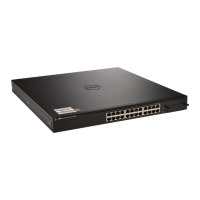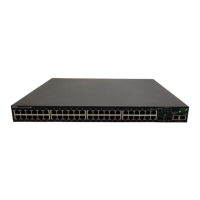Managing a Switch Stack 143
9
Managing a Switch Stack
This chapter describes how to configure and manage a stack of switches.
The topics covered in this chapter include:
• Stacking Overview
• Default Stacking Values
• Managing and Monitoring the Stack (Web)
• Managing the Stack (CLI)
• Stacking and NSF Usage Scenarios
Stacking Overview
PowerConnect 8000/8100-series switches support high performance stacking,
allowing increased capacity to be added as needed, without affecting network
performance and providing a single point of management.
Up to six PowerConnect 8024/8024F units can be stacked together using the
10G SFP+ fiber ports only. In other words, the copper 10 GbaseT ports on
the PC8024/PC8024F units cannot be used for stacking. When a combo port
is configured in stacking mode, the corresponding copper port is disabled.
The 10G SFP+ ports default to Ethernet mode, so the ports must be
reconfigured as stacking ports.
Also, up to six PowerConnect 8132/8132F/8164/8164F switches can be
stacked using any port as long as the link bandwidth for parallel stacking links
is the same. In other words, all the port types on the 8100 series switches can
be used for stacking.
If Priority Flow Control (PFC) is enabled on any port in the stack, stacking is
supported at distances up to 100 meters on the stacking ports. If PFC is not
enabled, stacking is supported up to the maximum distance supported by the
transceiver on the stack links. Note that PFC cannot be enabled on stacking
ports - the system handles the buffering and flow control automatically.

